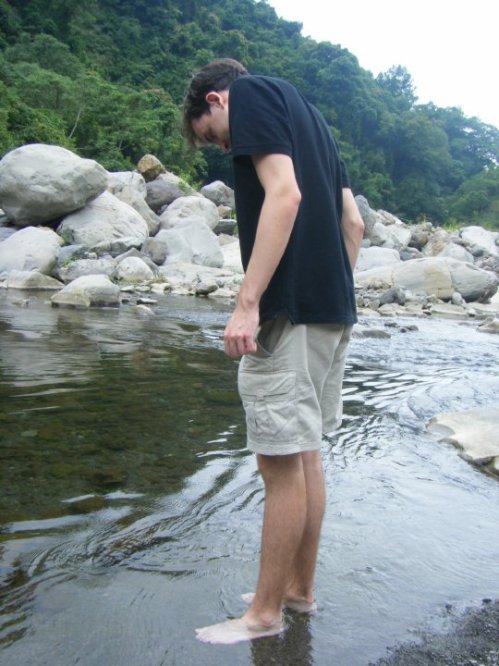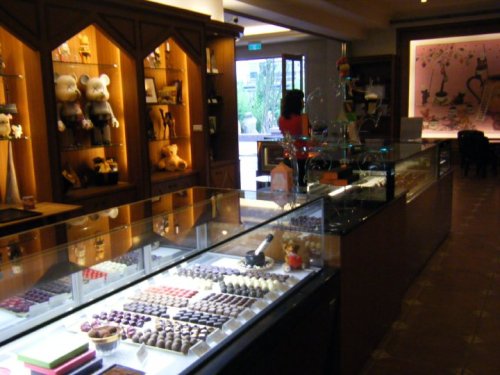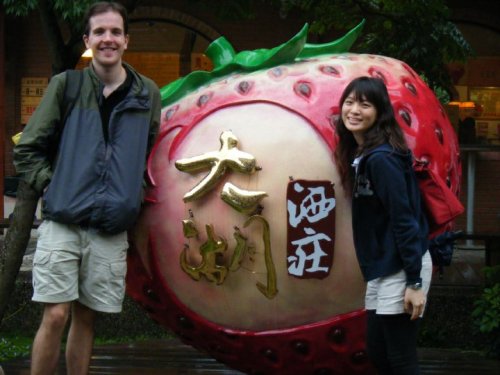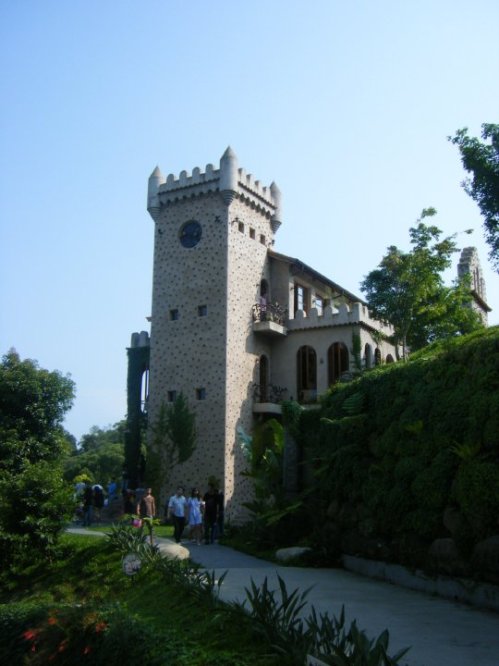Visiting Hualien reminded me how much of Taiwan I miss by living in a large city. Taiwan’s a developed country, but a large percentage of the population still lives in small, rural towns on or around mountains. Both the average standard of living and the tempo of daily life is very different a mile (or a few miles) high. In search of broader understanding, I jumped on Taiwanese Katherine’s suggestion to visit a few scenic towns in Taiwan’s mountainous northwest.
Our first stop was Sanyi, a town famous for its hot springs high up one of the mountains. The journey there is worth comment by itself. We took a train to Sanyi and then rented a scooter. We stopped by a ‘famous’ noodle place (for non-consistent readers, I use quotations marks because Taiwanese are far too quick to describe a place as ‘famous’) and then drove off in the dark. Katherine isn’t very comfortable driving up and down inclines, so I eventually took over all driving responsibilities.
Concentration was paramount during the drive. Once we began our ascent up the mountain, all we had was a comically windy two lane road. No shoulder, no street lights. It looked like something out of a Lexus commercial touting anti-lock breaks.
I still can’t say I enjoyed driving for two hours up a windy road in the pitch black, but one part of the drive impressed me. All of a sudden, after about an hour of altitude climbing, we descended down a huge hill. We drove speedily down a sharp decline for at least a full twenty five seconds. I realized about fifteen seconds into our descent that we must’ve been driving into a remarkably deep valley. Sure enough, after the road leveled for about a minute, we started on an equally steep incline.
Other than the small portion of the road illuminated by our headlights, we could see precisely none of the valley. Not even the outlines of a mountain or a tree. Katherine, raised to appreciate very different ancient cultural reference points, couldn’t connect with my feeling that we had just dipped into the Inferno, both Dantes driven along by our trusty scooter, Virgil. Another memory I won’t soon forget.
Taiwan is famous for its hot springs. A volcanic island, Taiwan is blessed with a number of rejuvenating hot springs locations throughout the island. Some hot springs’ waters are known for specific benefits. Sanyi is specifically known for the epidermal benefits of its hot, soothing waters. After a few hours guiding a scooter up a gigantic mountain, I was in the mood for something soothing.
Katherine is a master hotel shopper. For a very low price, she found us a room that included a large, en suite wooden hot springs tub. The hot springs relaxed my cramped shoulder muscles and left my skin feeling silky smooth. I’m often skeptical of Chinese medicine and health clichés, but I can no longer deny the skin benefits of hot springs. My skin felt wonderful.
If the theme of the first night was epidermal pleasure, the next day was all about culinary pleasure. Our first stop was Tofu Street (dofu jie), a two-hundred yard single lane road lined with tofu shops and restaurants. Tofu is a staple of the Taiwanese diet. Nutritionists consider it a ‘super food’ because of all its health benefits (e.g. it’s a rich source of protein without any of the negative effects of eating meat). Tofu street was a one-stop-shopping emporium for every conceivable variety of tofu.
Of course, Tofu Street had its very own ‘famous’ restaurant. I scoffed. This time around, however, I think maybe Taiwanese were on to something. The restaurant was one of the best cheap restaurants I’ve ever visited in Asia. We each had a bowl of noodles and split some fried tofu. The tofu was the main attraction, but everything was delicious.
By ‘cheap’ restaurant I don’t mean low-brow. Only recently have I started to realize that, in Taiwan and China at least, there’s a certain type of restaurant that doesn’t exist in the U.S. Like the U.S., Taiwan has your run of the mill Western-style sit down restaurant. It also has food stands.
What the U.S. lacks are the cheap, informal ‘restaurants’ that predominate in Taiwan. What do they look like? The owner buys a small kitchen on a part of the first floor of a building. He or she then buys a bunch of foldable chairs and plastic stools and scatters them around the interior space and out on to the sidewalk. Customers place their orders at the kitchen, stop by a chopstick/soy sauce stand to gather what they need, and sit and wait at their tables for their food. Western-style sit down restaurants with wooden tables, table cloths or placemats, prelaid utensils etc. are very popular here, but they’re more expensive and less well attended than the cheap restaurants.

So as not to sound too repetitive over the next few days of writing about trips to mountains, I'm not going to delve into every beautiful moment touring the natural landscape. I'll let pictures speak their thousands of words.

A fresh water stream from the melting snows atop Yushan Mountain, Taiwan's tallest peak. I wanted to cool down my feet after a little hike.
Anyway, back to the narrative. Our second culinary stop was quite different than Tofu Street. “Shokolate” is an upscale chocolate shop built in English manor style in the middle of wide, trimmed green lawns and flower garden paths. An appealing testament to upper-middle class Taiwanese folks’ wish to experience European culture. I thanked the heavens for my many paid tutoring jobs, bought five gourmet chocolate pieces and sampled them with Katherine in the middle of one of the lawns. It felt really strange to eat gourmet chocolate (in Western flavors like ‘Earl Grey’) on a manicured lawn set on the side of a Taiwanese mountain.
Next up was the town of Dahu. Dahu revolves around the Dahu Strawberry Farmer’s Association. The farmers run a large market selling hundreds of varieties of strawberry products. I ate strawberry-flavored sausage, made by brushing strawberry preserve on grilled sausages. Delicious. We tried puff pastry filled with strawberry custard. Delicious. I drank a tall glass of iced strawberry milk tea. Ibid. We rested a bit and waited out a rain storm in the market’s café, marveling at the strawberry splendor.
Our final culinary stop of the day was at the awesomely-named ‘Mile High Café.’ Guess how high in the sky it is. It’s a family-run restaurant built on the side of a cliff. If you jumped over the railing at the far end of the restaurant, you’d fall pretty far. A legitimate cliff, with a beautiful view of the mountains and valleys extending as far as the eye can see. The restaurant churned out high quality Taiwanese foods like hot pot and tofu with tomato. Another excellent meal.

The Mile High Cafe is in the same town as ginger farms. The snowman's body is made of ginger. I can't get over how truly absurd this is.
The aesthetic inside the Mile High Cafe was a microcosm of Taiwan’s cultural hodgepodge approach to upper-middle class dining. The really elite places are always faithful representations of Eastern or Western culture and cuisine. My favorite places are the upper-middle range restaurants, the kinds of places where you can sit on nice chairs yet eat on disposable table cloths (traditionally, Taiwanese meat consumed at restaurant will still have some bones, so you’re expected to take the bones from your mouth with your chopsticks and just leave them to the side of your rice bowl), where the service is excellent yet you’re still expected to get up and go to the rice cooker to scoop yourself some rice, where the speakers play a steady stream of Louis Armstrong yet the owner’s mother sits by the door selling freshly picked Taiwanese plums. A delightful mélange.
Our hotel for the night was priced at the upper-middle range, but its cultural representation was spot-on. ‘Maison Philo’ (French for “The Philosophy Home”) is a European-themed hotel run by a native Taiwanese woman. It was one of the most charming hotels I’ve ever visited.
Initially, one is struck by the strange shape of the hotel. I couldn’t really see it, but the owner told Katherine she modeled the shape of her hotel to represent an owl’s head. All I saw was a circular white building with large windows.
If there’s anything to nitpick about the hotel’s fidelity to its cultural model, it’s how over the top (yet consistently accurate) it is in trumpeting the owner’s understanding of European culture. You walk through the large oak doors and are immediately confronted by a mural of Raphael’s “Academy.” Probably not what you’d find at your average French B&B, but who can argue with the “Academy” as a choice?
The philosophy major in me deeply appreciated the way the hotel owner ordered the rooms. No numbers. Names. Specifically, the names of famous philosophers. Each of the four rooms on the second floor was named after a famous philosopher, and then decorated according to the national style of the philosopher’s home. Katherine chose Bertrand Russell because she liked the English style, but one could choose Aristotle, Descartes or some Arab philosopher I couldn’t discern because I can’t read Arabic (heck, I was impressed I could read enough Ancient Greek to read “Aristotle”). Each room includes a few translated, dog-eared copies of the resident philosopher’s works. Was I swooning almost as much as Katherine? You bet.
Katherine’s full swoon set in when we visited what to me was hands down the oddest part of the trip: a castle in the middle of a Taiwanese mountain range. Before you rush to your Encyclopedia Britannica (or—who are we kidding?—Wikipedia), note that this ‘castle’ is not what most Westerners take to mean castle, viz. a large residence which long ago housed aristocrats. Instead, the ‘castle’ is a recently constructed, modernly furnished restaurant/giant photo op with a really pretty view of a nearby valley. If Shokolate and its gardens was faithful enough to its ideal to simply confuse, the castle was so off the mark it was just hilarious. I try hard not to snicker at the enthusiasm of Taiwanese for Western treasures, but I couldn’t help myself at the castle. In its own right it’s quite pretty and it has a drop-dead gorgeous view from its restaurant, but it’s a far, far cry from a legitimate castle.
I wound up spending most of the weekend at tourist spots, removed from the small rural towns. The indelible images of the weekend were the beautiful views of the mountain ranges, the Inferno’esque descent into a pitch black valley, the soothing texture of my post-hot springs skin, and the strange castles and chocolatiers dropped in the middle of nowhere.
Yet I continue to be drawn to the small towns. I’m a city kid, through and through. By the time I register that I’m driving through a small town, the town is halfway behind me. I can’t really imagine how I’d get on two miles from sea level, living with one hundred other people two hours drive away from the market. I’m always enchanted by the image of the old Taiwanese farmer sitting on a plastic chair outside his small, corrugated metal roofed house. It’s such a mystery to me. It may not sound like it when I write about it, but that guy in his blue chair remains with me just as much as the taste of Earl Grey gourmet chocolate or strawberry sausage.
The man in the chair also represents another significant fact: Taiwan is a developed country, one of the thirty most affluent “places” in the world (note the word “places,” State Department lawyers!). But the average income here is only slightly more than half of America’s. This place often strikes me as a pretty poor country, mostly when I venture out of Kaohsiung. Taiwan doesn’t need your charity, but an accurate mental representation of Ille Formosa requires an awareness of how far Taiwan has yet to grow.











